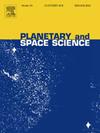An Arctic analogue for the future exploration of possible biosignatures on Enceladus
IF 1.7
4区 物理与天体物理
Q3 ASTRONOMY & ASTROPHYSICS
引用次数: 0
Abstract
Methane-rich emissions to the seafloor along the Arctic mid-oceanic ridge hold strong astrobiological significance, as they may represent analogues of putative hydrothermal vent environments on Enceladus. Although such environments on Enceladus would be ideal to sample in future astrobiological missions, this may not be possible due to technological and logistical limitations. As such, searching for biosignatures in the more readily sampled cryovolcanic plumes or Enceladus’ icy shell is preferable. In this regard, the Arctic Ocean, where the geologically active seafloor is covered by thousands of metres of salty water and sealed by an ice cap, is a unique terrestrial analogue of Enceladus. In the present study, we have sought to determine whether any geochemical biosignatures associated with methane cycling (e.g., elevated methane concentrations, carbon isotopic fractionation) can be detected in Arctic ice and seawater samples using mass spectrometric techniques similar to those likely to be included in the payloads of planned missions to Enceladus. Our results have shown that, although no unequivocal evidence of methane could be detected in our Arctic samples, the carbon isotopic composition of carbon dioxide gas and the oxygen isotopic composition of water vapour emitted from the Arctic samples could indeed be measured. Furthermore, an excess of molecular hydrogen with abundances comparable to the composition of Enceladus’ southern pole plume was possibly observed in one of the Arctic ice samples. These results have implications for detectable indirect geochemical evidence of putative ecosystems of hydrogenotrophic methanogenic life on the seafloor of Enceladus and justify future efforts at method development and refinement using apparatus similar to that likely to be included in the payloads of future missions.
一个北极模拟物,用于未来探索土卫二上可能的生物特征
沿北极洋中脊向海底排放的富含甲烷气体具有很强的天体生物学意义,因为它们可能代表了土卫二上假定的热液喷口环境的类似物。尽管在未来的天体生物学任务中,土卫二上的这种环境是理想的采样环境,但由于技术和后勤限制,这可能是不可能的。因此,在更容易取样的冰冻火山羽流或土卫二的冰壳中寻找生物特征是更可取的。在这方面,北冰洋地质活动活跃的海底被数千米的咸水覆盖,并被冰盖密封,是土卫二独特的陆地模拟物。在目前的研究中,我们试图确定是否可以在北极冰和海水样本中检测到与甲烷循环相关的任何地球化学生物特征(例如,甲烷浓度升高,碳同位素分馏),使用的质谱技术类似于计划中的土卫二任务有效载荷。我们的研究结果表明,尽管在我们的北极样本中没有检测到甲烷的明确证据,但从北极样本中排放的二氧化碳气体的碳同位素组成和水蒸气的氧同位素组成确实可以测量出来。此外,在一个北极冰样本中,可能观察到过量的氢分子,其丰度与土卫二南极羽流的组成相当。这些结果对土卫二海底可能存在的氢营养产甲烷生物生态系统的可探测的间接地球化学证据产生了影响,并证明了未来在方法开发和改进方面的努力是合理的,使用类似于未来任务有效载荷中可能包括的仪器。
本文章由计算机程序翻译,如有差异,请以英文原文为准。
求助全文
约1分钟内获得全文
求助全文
来源期刊

Planetary and Space Science
地学天文-天文与天体物理
CiteScore
5.40
自引率
4.20%
发文量
126
审稿时长
15 weeks
期刊介绍:
Planetary and Space Science publishes original articles as well as short communications (letters). Ground-based and space-borne instrumentation and laboratory simulation of solar system processes are included. The following fields of planetary and solar system research are covered:
• Celestial mechanics, including dynamical evolution of the solar system, gravitational captures and resonances, relativistic effects, tracking and dynamics
• Cosmochemistry and origin, including all aspects of the formation and initial physical and chemical evolution of the solar system
• Terrestrial planets and satellites, including the physics of the interiors, geology and morphology of the surfaces, tectonics, mineralogy and dating
• Outer planets and satellites, including formation and evolution, remote sensing at all wavelengths and in situ measurements
• Planetary atmospheres, including formation and evolution, circulation and meteorology, boundary layers, remote sensing and laboratory simulation
• Planetary magnetospheres and ionospheres, including origin of magnetic fields, magnetospheric plasma and radiation belts, and their interaction with the sun, the solar wind and satellites
• Small bodies, dust and rings, including asteroids, comets and zodiacal light and their interaction with the solar radiation and the solar wind
• Exobiology, including origin of life, detection of planetary ecosystems and pre-biological phenomena in the solar system and laboratory simulations
• Extrasolar systems, including the detection and/or the detectability of exoplanets and planetary systems, their formation and evolution, the physical and chemical properties of the exoplanets
• History of planetary and space research
 求助内容:
求助内容: 应助结果提醒方式:
应助结果提醒方式:


